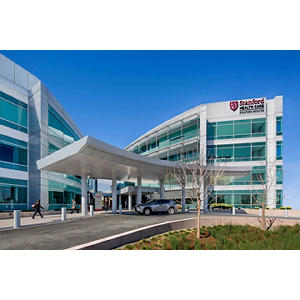
Anthony Oro, MD
Professor
Dermatology
Localización

450 Broadway Street
Redwood City, CA 94063
Mapas, direcciones y estacionamiento
Teléfono : (844) 416-7846

900 Blake Wilbur Drive, W0001
Stanford, CA 94305
Mapas, direcciones y estacionamiento
Teléfono : (650) 723-6316
Trabajo y educación
University of California San Diego School of Medicine, La Jolla, CA, 05/31/1993
Stanford University Dermatology Residency, Redwood City, CA, 06/30/1997
Stanford University Internal Medicine Residency, Stanford, CA, 06/30/1994
Dermatology, American Board of Dermatology, 1998
Idiomas
English
Publicaciones
Functional genotype classification groups distinguish disease severity in recessive dystrophic epidermolysis bullosa. The British journal of dermatology 2025
Recessive dystrophic epidermolysis bullosa (RDEB) is a genetic disorder due to pathogenic variants in the COL7A1 gene. In this study we determined the association between different categories of COL7A1 variants and clinical disease severity in 236 RDEB patients in North America. Published reports or in-silico predictions were used to assess the impact of pathogenic variants in COL7A1 on type VII collagen (C7) protein function. Three impact categories were postulated: genotypes that would likely cause a low impact on C7 function (splice B/missense, missense/missense), medium impact [premature termination codon (PTC)/splice B, splice A/splice B, PTC/missense, splice A/missense, splice B/splice B] and high impact (PTC/PTC, PTC/splice A, splice A/splice A). Splice A variants are predicted to cause downstream PTCs while splice B variants cause in-frame exon skipping and are therefore less deleterious. Severity of functional impact was significantly associated with history of gastrostomy tube placement, esophageal dilation, hand surgery, anemia, renal disease, chronic wounds, diffuse skin involvement and history of squamous cell carcinoma. Odds of death were 3.25 (1.24-8.50, p=0.02) higher in the high vs medium impact group. High impact group patients had worse clinical outcomes. Functional genotype categories are a feasible approach to risk stratify patients based on predicted C7 function.
View details for DOI 10.1093/bjd/ljaf015
View details for PubMedID 39790012
A spatiotemporal and machine-learning platform facilitates the manufacturing of hPSC-derived esophageal mucosa. Developmental cell 2025
Human pluripotent stem cell-derived tissue engineering offers great promise for designer cell-based personalized therapeutics, but harnessing such potential requires a deeper understanding of tissue-level interactions. We previously developed a cell replacement manufacturing method for ectoderm-derived skin epithelium. However, it remains challenging to manufacture the endoderm-derived esophageal epithelium despite possessing a similar stratified epithelial structure. Here, we employ single-cell and spatial technologies to generate a spatiotemporal multi-omics cell census for human esophageal development. We identify the cellular diversity, dynamics, and signal communications for the developing esophageal epithelium and stroma. Using Manatee, a machine-learning algorithm, we prioritize the combinations of candidate human developmental signals for in vitro derivation of esophageal basal cells. Functional validation of Manatee predictions leads to a clinically compatible system for manufacturing human esophageal mucosa.
View details for DOI 10.1016/j.devcel.2024.12.030
View details for PubMedID 39798574
Basal-to-inflammatory transition and tumor resistance via crosstalk with a pro-inflammatory stromal niche. Nature communications 2024; 15 (1): 8134
Cancer-associated inflammation is a double-edged sword possessing both pro- and anti-tumor properties through ill-defined tumor-immune dynamics. While we previously identified a carcinoma tumor-intrinsic resistance pathway, basal-to-squamous cell carcinoma transition, here, employing a multipronged single-cell and spatial-omics approach, we identify an inflammation and therapy-enriched tumor state we term basal-to-inflammatory transition. Basal-to-inflammatory transition signature correlates with poor overall patient survival in many epithelial tumors. Basal-to-squamous cell carcinoma transition and basal-to-inflammatory transition occur in adjacent but distinct regions of a single tumor: basal-to-squamous cell carcinoma transition arises within the core tumor nodule, while basal-to-inflammatory transition emerges from a specialized inflammatory environment defined by a tumor-associated TREM1 myeloid signature. TREM1 myeloid-derived cytokines IL1 and OSM induce basal-to-inflammatory transition in vitro and in vivo through NF-κB, lowering sensitivity of patient basal cell carcinoma explant tumors to Smoothened inhibitor treatment. This work deepens our knowledge of the heterogeneous local tumor microenvironment and nominates basal-to-inflammatory transition as a drug-resistant but targetable tumor state driven by a specialized inflammatory microenvironment.
View details for DOI 10.1038/s41467-024-52394-3
View details for PubMedID 39289380
View details for PubMedCentralID 7613740
A scalable and cGMP-compatible autologous organotypic cell therapy for Dystrophic Epidermolysis Bullosa. Nature communications 2024; 15 (1): 5834
We present Dystrophic Epidermolysis Bullosa Cell Therapy (DEBCT), a scalable platform producing autologous organotypic iPS cell-derived induced skin composite (iSC) grafts for definitive treatment. Clinical-grade manufacturing integrates CRISPR-mediated genetic correction with reprogramming into one step, accelerating derivation of COL7A1-edited iPS cells from patients. Differentiation into epidermal, dermal and melanocyte progenitors is followed by CD49f-enrichment, minimizing maturation heterogeneity. Mouse xenografting of iSCs from four patients with different mutations demonstrates disease modifying activity at 1 month. Next-generation sequencing, biodistribution and tumorigenicity assays establish a favorable safety profile at 1-9 months. Single cell transcriptomics reveals that iSCs are composed of the major skin cell lineages and include prominent holoclone stem cell-like signatures of keratinocytes, and the recently described Gibbin-dependent signature of fibroblasts. The latter correlates with enhanced graftability of iSCs. In conclusion, DEBCT overcomes manufacturing and safety roadblocks and establishes a reproducible, safe, and cGMP-compatible therapeutic approach to heal lesions of DEB patients.
View details for DOI 10.1038/s41467-024-49400-z
View details for PubMedID 38992003
View details for PubMedCentralID PMC11239819
The manatee variational autoencoder model for predicting gene expression alterations caused by transcription factor perturbations. Scientific reports 2024; 14 (1): 11794
We present the Manatee variational autoencoder model to predict transcription factor (TF) perturbation-induced transcriptomes. We demonstrate that the Manatee in silico perturbation analysis recapitulates target transcriptomic phenotypes in diverse cellular lineage transitions. We further propose the Manatee in silico screening analysis for prioritizing TF combinations targeting desired transcriptomic phenotypes.
View details for DOI 10.1038/s41598-024-62620-z
View details for PubMedID 38782963
View details for PubMedCentralID PMC11116378
Basal-to-inflammatory transition and tumor resistance via crosstalk with a proinflammatory stromal niche Nature Communications 2024; 15
View details for DOI 10.1038/s41467-024-52394-3
Integrated single-cell chromatin and transcriptomic analyses of human scalp identify gene-regulatory programs and critical cell types for hair and skin diseases. Nature genetics 2023
Genome-wide association studies have identified many loci associated with hair and skin disease, but identification of causal variants requires deciphering of gene-regulatory networks in relevant cell types. We generated matched single-cell chromatin profiles and transcriptomes from scalp tissue from healthy controls and patients with alopecia areata, identifying diverse cell types of the hair follicle niche. By interrogating these datasets at multiple levels of cellular resolution, we infer 50-100% more enhancer-gene links than previous approaches and show that aggregate enhancer accessibility for highly regulated genes predicts expression. We use these gene-regulatory maps to prioritize cell types, genes and causal variants implicated in the pathobiology of androgenetic alopecia (AGA), eczema and other complex traits. AGA genome-wide association studies signals are enriched in dermal papilla regulatory regions, supporting the role of these cells as drivers of AGA pathogenesis. Finally, we train machine learning models to nominate single-nucleotide polymorphisms that affect gene expression through disruption of transcription factor binding, predicting candidate functional single-nucleotide polymorphism for AGA and eczema.
View details for DOI 10.1038/s41588-023-01445-4
View details for PubMedID 37500727
View details for PubMedCentralID 4006068
Acquisition of drug resistance in basal cell nevus syndrome tumors through basal to squamous cell carcinoma transition. bioRxiv : the preprint server for biology 2023
While basal cell carcinomas (BCCs) arise from ectopic hedgehog pathway activation and can be treated with pathway inhibitors, sporadic BCCs display high resistance rates while tumors arising in Gorlin syndrome patients with germline Patched ( PTCH1 ) mutations are uniformly suppressed by inhibitor therapy. In rare cases, Gorlin syndrome patients on long-term inhibitor therapy will develop individual resistant tumor clones that rapidly progress, but the basis of this resistance remains unstudied. Here we report a case of an SMO i -resistant tumor arising in a Gorlin patient on suppressive SMO i for nearly a decade. Using a combination of multi-omics and spatial transcriptomics, we define the tumor populations at the cellular and tissue level to conclude that Gorlin tumors can develop resistance to SMO i through the previously described basal to squamous cell carcinoma transition (BST). Intriguingly, through spatial whole exome genomic analysis, we nominate PCYT2, ETNK1, and the phosphatidylethanolamine biosynthetic pathway as novel genetic suppressors of BST resistance. These observations provide a general framework for studying tumor evolution and provide important clinical insight into mechanisms of resistance to SMO i for not only Gorlin syndrome but sporadic BCCs as well.
View details for DOI 10.1101/2023.07.26.550719
View details for PubMedID 37546976
Skin basal cell carcinomas assemble a pro-tumorigenic spatially organized and self-propagating Trem2+ myeloid niche. Nature communications 2023; 14 (1): 2685
Cancer immunotherapies have revolutionized treatment but have shown limited success as single-agent therapies highlighting the need to understand the origin, assembly, and dynamics of heterogeneous tumor immune niches. Here, we use single-cell and imaging-based spatial analysis to elucidate three microenvironmental neighborhoods surrounding the heterogeneous basal cell carcinoma tumor epithelia. Within the highly proliferative neighborhood, we find that TREM2+ skin cancer-associated macrophages (SCAMs) support the proliferation of a distinct tumor epithelial population through an immunosuppression-independent manner via oncostatin-M/JAK-STAT3 signaling. SCAMs represent a unique tumor-specific TREM2+ population defined by VCAM1 surface expression that is not found in normal homeostatic skin or during wound healing. Furthermore, SCAMs actively proliferate and self-propagate through multiple serial tumor passages, indicating long-term potential. The tumor rapidly drives SCAM differentiation, with intratumoral injections sufficient to instruct naive bone marrow-derived monocytes to polarize within days. This work provides mechanistic insights into direct tumor-immune niche dynamics independent of immunosuppression, providing the basis for potential combination tumor therapies.
View details for DOI 10.1038/s41467-023-37993-w
View details for PubMedID 37164949
GRHL2 and AP2a coordinate early surface ectoderm lineage commitment during development. iScience 2023; 26 (3): 106125
Ectodermal dysplasias including skin abnormalities and cleft lip/palate result from improper surface ectoderm (SE) patterning. However, the connection between SE gene regulatory networks and disease remains poorly understood. Here, we dissect human SE differentiation with multiomics and establish GRHL2 as a key mediator of early SE commitment, which acts by skewing cell fate away from the neural lineage. GRHL2 and master SE regulator AP2a balance early cell fate output, with GRHL2 facilitating AP2a binding to SE loci. In turn, AP2a restricts GRHL2 DNA binding away from de novo chromatin contacts. Integration of these regulatory sites with ectodermal dysplasia-associated genomic variants annotated within the Biomedical Data Commons identifies 55 loci previously implicated in craniofacial disorders. These include ABCA4/ARHGAP29 and NOG regulatory regions where disease-linked variants directly affect GRHL2/AP2a binding and gene transcription. These studies elucidate the logic underlying SE commitment and deepen our understanding of human oligogenic disease pathogenesis.
View details for DOI 10.1016/j.isci.2023.106125
View details for PubMedID 36843855
Conéctese con nosotros:
Descarga nuestra App: